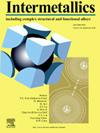Al-30at的本构建模与微观组织表征。高温变形时的%Sc金属间化合物
IF 4.8
2区 材料科学
Q2 CHEMISTRY, PHYSICAL
引用次数: 0
摘要
探讨高含量Sc、Al-30at铝的热变形机理。采用高真空电弧熔炼法制备了%Sc金属间化合物。等温热压缩(1000 ~ 1100℃,0.001 ~ 0.1 s−1)产生真应力-应变曲线,并推导出arrhenius型本构方程。基于动态材料模型,构建了热加工图。Al-30at的物性数据。计算构建了随温度变化的%Sc金属间化合物,并结合其本构方程成功应用于Deform-3D软件平台。结果表明,峰值应力和应变为0.3时的热变形激活能分别为421.1 kJ/mol和431.8 kJ/mol,预测和实验真实应力的相关系数为0.98,峰值功耗因子为0.58。晶粒尺寸随变形温度升高或应变速率降低而增大。纳米尺度的观察揭示了不同热变形条件下不同的位错结构和应变场集中区。Al-30at中形成了Al3Sc和Al2Sc析出相。%Sc金属间化合物。Al3Sc相的l12型有序结构阻碍了位错的运动,形成堆积和复杂的位错形态。Al2Sc和Al3Sc相的弹性模量差异导致应力场和应变场集中不均匀。本文章由计算机程序翻译,如有差异,请以英文原文为准。

Constitutive modeling and microstructure characterization of Al-30at.%Sc intermetallic compound during high temperature deformation
To explore the hot-deformation mechanism of Al with high-content Sc, an Al-30at.%Sc intermetallic compound is prepared via high-vacuum arc melting. Isothermal hot-compression (1000–1100 °C, 0.001–0.1 s−1) yield true stress-strain curves, and an Arrhenius-type constitutive equation is derived. A hot-processing map is constructed based on the dynamic material model. The physical property data of Al-30at.%Sc intermetallic compound (varying with temperature) was calculated and constructed, and successfully applied to the Deform-3D software platform in combination with its constitutive equation. Results show that the hot-deformation activation energy at the peak stress, and at a strain of 0.3 is 421.1 kJ/mol, and 431.8 kJ/mol, respectively, which produces a correlation coefficient of 0.98 between predicted and experimental true stress and the peak power-dissipation factor ∼0.58. Grain size increases with rising deformation temperature or decreasing strain rate. Nanoscale observation reveals different dislocation structures and strain-field concentration areas under various thermal-deformation conditions. Al3Sc and Al2Sc precipitated phases are formed in the Al-30at.%Sc intermetallic compound. The L12-type ordered structure of the Al3Sc phase blocks dislocation movement, causing pile-up and complex dislocation morphologies. The elastic-modulus difference between Al2Sc and Al3Sc phases leads to uneven stress and strain-field concentration.
求助全文
通过发布文献求助,成功后即可免费获取论文全文。
去求助
来源期刊

Intermetallics
工程技术-材料科学:综合
CiteScore
7.80
自引率
9.10%
发文量
291
审稿时长
37 days
期刊介绍:
This journal is a platform for publishing innovative research and overviews for advancing our understanding of the structure, property, and functionality of complex metallic alloys, including intermetallics, metallic glasses, and high entropy alloys.
The journal reports the science and engineering of metallic materials in the following aspects:
Theories and experiments which address the relationship between property and structure in all length scales.
Physical modeling and numerical simulations which provide a comprehensive understanding of experimental observations.
Stimulated methodologies to characterize the structure and chemistry of materials that correlate the properties.
Technological applications resulting from the understanding of property-structure relationship in materials.
Novel and cutting-edge results warranting rapid communication.
The journal also publishes special issues on selected topics and overviews by invitation only.
 求助内容:
求助内容: 应助结果提醒方式:
应助结果提醒方式:


